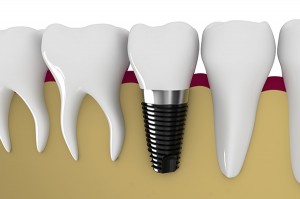Dental Implants and Your Facial Structure

We recommend
dental implants after tooth loss as a way to support and maintain your facial structure and appearance. If you have lost one or several teeth, it is important to replace them as quickly as possible. We have multiple solutions for doing so including dentures, bridges, and dental implants. By and large, we recommend implants because this is the most permanent solution to tooth loss and one that can help to preserve your facial structure. Here is why –
When you lose a tooth, the body will begin the process of resorption.
The jaw needs stimulation and your teeth provide it with the exact stimulation that it needs. When you lose a tooth, that area of the jaw is no longer stimulated and the body is alerted that it is no longer doing its job. That means that the calcium in that area of the jaw is not needed either. Since you have plenty of other bones in need of calcium, the body will then leach it from your jaw to be used elsewhere. As a result, your jaw can begin to shrink or deteriorate and your face will begin to appear sunken. This can make young people look far older than they are. To prevent this from happening to you, you need to replace your teeth and stimulate your jaw. An implant is the only solution that is surgically secured to your jaw so that it can receive the maximum level of stimulation.
The Process of Getting
Dental Implants
To start the process of getting an implant, we will examine you and take x-rays. This is to see if you have enough bone density to support an implant. If you do not, we have other procedures we can discuss or you can have a bone graft to further restore your jawbone. Once you are cleared for the procedure, we will schedule you for surgery. You will be given anesthesia so that you feel completely comfortable and may even go to sleep. We will then place a small titanium post under your gums and secure it to the jawbone in each spot where you are missing a tooth. This can take several hours and afterwards you will want to use ice and take ibuprofen to keep the swelling down.
Over the course of several months, the process of osseointegration will take place where the jawbone and implant will fuse together. Once done, your new implant will have the same level of support from the jawbone that your tooth did. We can then attach your new tooth (dental crown) to an abutment that is secured to the implant. When we are done, you will have a natural looking and beautiful replacement tooth.
The Benefits of
Dental Implants
Implants look, behave, and feel like natural teeth. Once they are in place, you will not be able to tell the difference between your natural teeth and your implants. You can eat all of your favorite foods, run a marathon and sing in the choir without worrying about your teeth. Best of all, an implant will provide your jaw with the stimulation it needs to prevent resorption and preserve your appearance.
 We recommend
We recommend 
